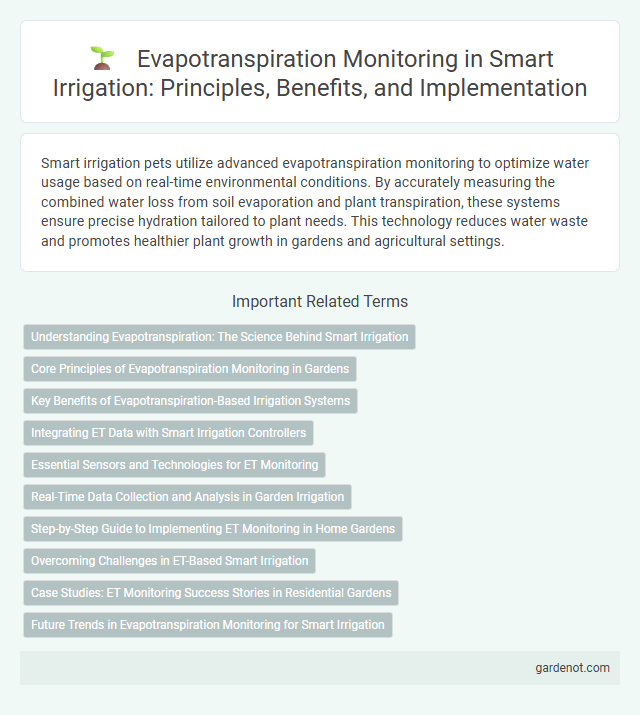Smart irrigation pets utilize advanced evapotranspiration monitoring to optimize water usage based on real-time environmental conditions. By accurately measuring the combined water loss from soil evaporation and plant transpiration, these systems ensure precise hydration tailored to plant needs. This technology reduces water waste and promotes healthier plant growth in gardens and agricultural settings.
Understanding Evapotranspiration: The Science Behind Smart Irrigation
Evapotranspiration (ET) measures water loss through evaporation from soil and transpiration from plants, serving as a critical factor in smart irrigation systems to optimize water usage. Accurate ET monitoring integrates weather data, soil moisture, and crop type, enabling precise irrigation scheduling that conserves water and promotes healthy plant growth. Advanced sensors and satellite imagery enhance ET estimation, providing actionable insights to reduce water waste and improve agricultural productivity.
Core Principles of Evapotranspiration Monitoring in Gardens
Evapotranspiration monitoring in gardens involves measuring the combined water loss from soil evaporation and plant transpiration to optimize irrigation schedules. Utilizing sensors and weather data, this monitoring guides precise water application by correlating environmental variables like temperature, humidity, solar radiation, and wind speed with plant water needs. Core principles include assessing local microclimates, soil moisture levels, and plant species characteristics to ensure sustainable water use and promote healthy garden growth.
Key Benefits of Evapotranspiration-Based Irrigation Systems
Evapotranspiration-based irrigation systems precisely measure water loss from soil and plants, enabling efficient water use that reduces wastage and lowers operational costs. These systems enhance crop health by delivering optimal moisture levels tailored to actual plant needs, improving yield quality and quantity. Real-time data integration allows for adaptive irrigation scheduling, conserving water resources and promoting sustainable agricultural practices.
Integrating ET Data with Smart Irrigation Controllers
Integrating evapotranspiration (ET) data with smart irrigation controllers enables precise water scheduling by continuously adjusting irrigation based on real-time crop water needs. Sensors and weather stations capture ET rates, which are analyzed to optimize irrigation timing and volume, reducing water waste and enhancing crop yield. This data-driven approach maximizes water use efficiency while supporting sustainable agricultural practices.
Essential Sensors and Technologies for ET Monitoring
Evapotranspiration monitoring relies on essential sensors such as soil moisture sensors, weather stations, and solar radiation sensors to accurately measure water loss from soil and plants. Advanced technologies like remote sensing, IoT-enabled devices, and data analytics platforms enhance the precision and real-time tracking of ET rates. Integrating these sensors with smart irrigation systems optimizes water usage by tailoring irrigation schedules based on actual evapotranspiration data.
Real-Time Data Collection and Analysis in Garden Irrigation
Evapotranspiration monitoring leverages real-time data collection and analysis to optimize garden irrigation schedules, reducing water waste and promoting plant health. Advanced sensors measure temperature, humidity, solar radiation, and soil moisture, providing precise evapotranspiration rates for tailored watering. Integrating this data with smart irrigation systems ensures efficient water use aligned with actual plant water needs.
Step-by-Step Guide to Implementing ET Monitoring in Home Gardens
Measure local weather data such as temperature, humidity, wind speed, and solar radiation using affordable sensors or weather stations to calculate accurate evapotranspiration (ET) rates for your home garden. Install soil moisture sensors at root zone depth to correlate ET data with actual soil water content, enabling precise irrigation scheduling based on plant water demands. Use ET monitoring software or apps that integrate weather inputs and sensor data to automate irrigation timing and volume, optimizing water use efficiency and promoting healthy plant growth.
Overcoming Challenges in ET-Based Smart Irrigation
Accurate evapotranspiration (ET) monitoring in smart irrigation requires overcoming challenges such as variability in microclimates, sensor calibration, and data integration from diverse sources. Advanced machine learning algorithms and IoT-enabled sensors enhance precision by analyzing real-time weather data, soil moisture, and crop type, optimizing water use efficiency. Implementing adaptive ET models tailored to local conditions significantly reduces water waste while ensuring optimal plant health and yield.
Case Studies: ET Monitoring Success Stories in Residential Gardens
Evapotranspiration (ET) monitoring in residential gardens has demonstrated significant water savings, with case studies revealing up to 30% reduction in irrigation without compromising plant health. These successes rely on integrating soil moisture sensors and local weather data to precisely adjust watering schedules based on daily ET rates. Homeowners report enhanced plant growth and sustainability, highlighting the efficacy of ET-based smart irrigation systems in optimizing water use and promoting eco-friendly gardening practices.
Future Trends in Evapotranspiration Monitoring for Smart Irrigation
Future trends in evapotranspiration monitoring for smart irrigation emphasize the integration of IoT sensors and AI-driven analytics to enhance real-time water usage efficiency. Advances in satellite remote sensing combined with machine learning models enable precise microclimate data capturing, optimizing irrigation schedules based on crop-specific water requirements. The deployment of edge computing devices facilitates rapid data processing onsite, reducing latency and enabling adaptive irrigation systems that respond dynamically to environmental fluctuations.
Evapotranspiration monitoring Infographic

 gardenot.com
gardenot.com